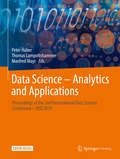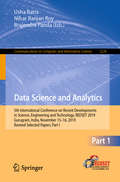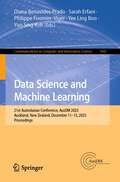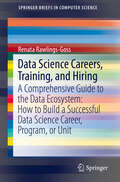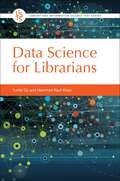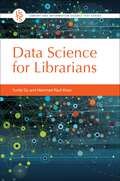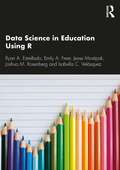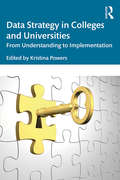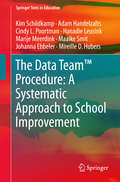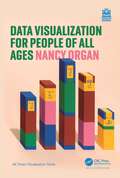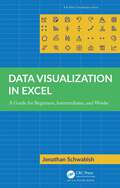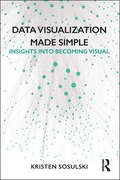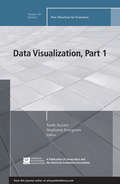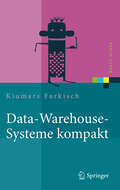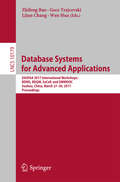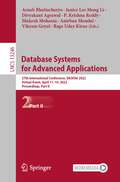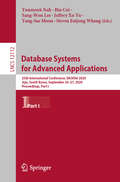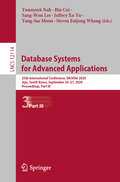- Table View
- List View
Data Science – Analytics and Applications: Proceedings of the 2nd International Data Science Conference – iDSC2019
This book offers the proceedings of the Second International Data Science Conference (iDSC2019), organized by Salzburg University of Applied Sciences, Austria. The Conference brought together researchers, scientists, and business experts to discuss new ways of embracing agile approaches to various facets of data science, including machine learning and artificial intelligence, data mining, data visualization, and communication. The papers gathered here include case studies of applied techniques, and theoretical papers that push the field into the future. The full-length scientific-track papers on Data Analytics are broadly grouped by category, including Complexity; NLP and Semantics; Modelling; and Comprehensibility. Included among real-world applications of data science are papers on Exploring insider trading using hypernetworksData-driven approach to detection of autism spectrum disorderAnonymization and sentiment analysis of Twitter posts Theoretical papers in the book cover such topics as Optimal Regression Tree Models Through Mixed Integer Programming; Chance Influence in Datasets with Large Number of Features; Adversarial Networks — A Technology for Image Augmentation; and Optimal Regression Tree Models Through Mixed Integer Programming. Five shorter student-track papers are also published here, on topics such as State-of-the-art Deep Learning Methods to effect Neural Machine Translation from Natural Language into SQLA Smart Recommendation System to Simplify Projecting for a HMI/SCADA Platform Use of Adversarial Networks as a Technology for Image AugmentationUsing Supervised Learning to Predict the Reliability of a Welding Process The work collected in this volume of proceedings will provide researchers and practitioners with a detailed snapshot of current progress in the field of data science. Moreover, it will stimulate new study, research, and the development of new applications.
Data Science and Analytics: 5th International Conference on Recent Developments in Science, Engineering and Technology, REDSET 2019, Gurugram, India, November 15–16, 2019, Revised Selected Papers, Part I (Communications in Computer and Information Science #1229)
by Usha Batra Nihar Ranjan Roy Brajendra PandaThis two-volume set (CCIS 1229 and CCIS 1230) constitutes the refereed proceedings of the 5th International Conference on Recent Developments in Science, Engineering and Technology, REDSET 2019, held in Gurugram, India, in November 2019. The 74 revised full papers presented were carefully reviewed and selected from total 353 submissions. The papers are organized in topical sections on data centric programming; next generation computing; social and web analytics; security in data science analytics; big data analytics.
Data Science and Machine Learning: 21st Australasian Conference, AusDM 2023, Auckland, New Zealand, December 11–13, 2023, Proceedings (Communications in Computer and Information Science #1943)
by Diana Benavides-Prado Sarah Erfani Philippe Fournier-Viger Yee Ling Boo Yun Sing KohThis book constitutes the proceedings of the 21st Australasian Conference on Data Science and Machine Learning, AusDM 2023, held in Auckland, New Zealand, during December 11–13, 2023.The 20 full papers presented in this book were carefully reviewed and selected from 50 submissions. The papers are organized in the following topical sections: research track and application track. They deal with topics around data science and machine learning in everyday life.
Data Science Careers, Training, and Hiring: A Comprehensive Guide to the Data Ecosystem: How to Build a Successful Data Science Career, Program, or Unit (SpringerBriefs in Computer Science)
by Renata Rawlings-GossThis book is an information packed overview of how to structure a data science career, a data science degree program, and how to hire a data science team, including resources and insights from the authors experience with national and international large-scale data projects as well as industry, academic and government partnerships, education, and workforce. Outlined here are tips and insights into navigating the data ecosystem as it currently stands, including career skills, current training programs, as well as practical hiring help and resources. Also, threaded through the book is the outline of a data ecosystem, as it could ultimately emerge, and how career seekers, training programs, and hiring managers can steer their careers, degree programs, and organizations to align with the broader future of data science. Instead of riding the current wave, the author ultimately seeks to help professionals, programs, and organizations alike prepare a sustainable plan for growth in this ever-changing world of data. The book is divided into three sections, the first “Building Data Careers”, is from the perspective of a potential career seeker interested in a career in data, the second “Building Data Programs” is from the perspective of a newly forming data science degree or training program, and the third “Building Data Talent and Workforce” is from the perspective of a Data and Analytics Hiring Manager. Each is a detailed introduction to the topic with practical steps and professional recommendations. The reason for presenting the book from different points of view is that, in the fast-paced data landscape, it is helpful to each group to more thoroughly understand the desires and challenges of the other. It will, for example, help the career seekers to understand best practices for hiring managers to better position themselves for jobs. It will be invaluable for data training programs to gain the perspective of career seekers, who they want to help and attract as students. Also, hiring managers will not only need data talent to hire, but workforce pipelines that can only come from partnerships with universities, data training programs, and educational experts. The interplay gives a broader perspective from which to build.
Data Science for Librarians (Library and Information Science Text Series)
by Yunfei Du Hammad Rauf KhanThis unique textbook intersects traditional library science with data science principles that readers will find useful in implementing or improving data services within their libraries.Data Science for Librarians introduces data science to students and practitioners in library services. Writing for academic, public, and school library managers; library science students; and library and information science educators, authors Yunfei Du and Hammad Rauf Khan provide a thorough overview of conceptual and practical tools for data librarian practice. Partially due to how quickly data science evolves, libraries have yet to recognize core competencies and skills required to perform the job duties of a data librarian. As society transitions from the information age into the era of big data, librarians and information professionals require new knowledge and skills to stay current and take on new job roles, such as data librarianship. Such skills as data curation, research data management, statistical analysis, business analytics, visualization, smart city data, and learning analytics are relevant in library services today and will become increasingly so in the near future. This text serves as a tool for library and information science students and educators working on data science curriculum design.
Data Science for Librarians (Library and Information Science Text Series)
by Yunfei Du Hammad Rauf KhanThis unique textbook intersects traditional library science with data science principles that readers will find useful in implementing or improving data services within their libraries.Data Science for Librarians introduces data science to students and practitioners in library services. Writing for academic, public, and school library managers; library science students; and library and information science educators, authors Yunfei Du and Hammad Rauf Khan provide a thorough overview of conceptual and practical tools for data librarian practice. Partially due to how quickly data science evolves, libraries have yet to recognize core competencies and skills required to perform the job duties of a data librarian. As society transitions from the information age into the era of big data, librarians and information professionals require new knowledge and skills to stay current and take on new job roles, such as data librarianship. Such skills as data curation, research data management, statistical analysis, business analytics, visualization, smart city data, and learning analytics are relevant in library services today and will become increasingly so in the near future. This text serves as a tool for library and information science students and educators working on data science curriculum design.
Data Science in Education Using R
by Ryan A. Estrellado Emily A. Freer Jesse Mostipak Joshua M. Rosenberg Isabella C. VelásquezData Science in Education Using R is the go-to reference for learning data science in the education field. The book answers questions like: What does a data scientist in education do? How do I get started learning R, the popular open-source statistical programming language? And what does a data analysis project in education look like? If you’re just getting started with R in an education job, this is the book you’ll want with you. This book gets you started with R by teaching the building blocks of programming that you’ll use many times in your career. The book takes a "learn by doing" approach and offers eight analysis walkthroughs that show you a data analysis from start to finish, complete with code for you to practice with. The book finishes with how to get involved in the data science community and how to integrate data science in your education job. This book will be an essential resource for education professionals and researchers looking to increase their data analysis skills as part of their professional and academic development.
Data Science in Education Using R
by Ryan A. Estrellado Emily A. Freer Jesse Mostipak Joshua M. Rosenberg Isabella C. VelásquezData Science in Education Using R is the go-to reference for learning data science in the education field. The book answers questions like: What does a data scientist in education do? How do I get started learning R, the popular open-source statistical programming language? And what does a data analysis project in education look like? If you’re just getting started with R in an education job, this is the book you’ll want with you. This book gets you started with R by teaching the building blocks of programming that you’ll use many times in your career. The book takes a "learn by doing" approach and offers eight analysis walkthroughs that show you a data analysis from start to finish, complete with code for you to practice with. The book finishes with how to get involved in the data science community and how to integrate data science in your education job. This book will be an essential resource for education professionals and researchers looking to increase their data analysis skills as part of their professional and academic development.
Data Strategy in Colleges and Universities: From Understanding to Implementation
by Kristina PowersThis valuable resource helps institutional leaders understand and implement a data strategy at their college or university that maximizes benefits to all creators and users of data. Exploring key considerations necessary for coordination of fragmented resources and the development of an effective, cohesive data strategy, this book brings together professionals from different higher education experiences and perspectives, including academic, administration, institutional research, information technology, and student affairs. Focusing on critical elements of data strategy and governance, each chapter in Data Strategy in Colleges and Universities helps higher education leaders address a frustrating problem with much-needed solutions for fostering a collaborative, data-driven strategy.
Data Strategy in Colleges and Universities: From Understanding to Implementation
by Kristina PowersThis valuable resource helps institutional leaders understand and implement a data strategy at their college or university that maximizes benefits to all creators and users of data. Exploring key considerations necessary for coordination of fragmented resources and the development of an effective, cohesive data strategy, this book brings together professionals from different higher education experiences and perspectives, including academic, administration, institutional research, information technology, and student affairs. Focusing on critical elements of data strategy and governance, each chapter in Data Strategy in Colleges and Universities helps higher education leaders address a frustrating problem with much-needed solutions for fostering a collaborative, data-driven strategy.
The Data Team™ Procedure: A Systematic Approach to School Improvement (Springer Texts in Education)
by Kim Schildkamp Adam Handelzalts Cindy L. Poortman Hanadie Leusink Marije Meerdink Maaike Smit Johanna Ebbeler Mireille D. HubersThis book describes the Data Team Procedure: a method for data-based decision making that can help schools to improve their quality. It involves the use of teams consisting of 4-6 teachers, 1-2 school leaders and a data expert. The members of the team collaboratively learn how to use data to solve an educational problem within the school, adopting a systematic approach. The data team procedure is an iterative and cyclic procedure consisting of eight steps. The data team members are trained in the data team procedure by a coach. The coach visits the data team’s school regularly for a meeting and facilitates working according to the systematic procedure. Teams participate in data analysis workshops for more specific support. Divided into three parts, the book first describes the importance of data use and the data team procedure. Next, it describes two cases. The first case concerns a data team working on a school level problem: Reducing grade repetition. The second case concerns a data team working on a classroom level problem: low student achievement in English language. The last part of the book explains what it means to implement the data team procedure in the school, the conditions needed for implementing the data team procedure, and the factors that may hinder or support the use of data in data teams.
Data Visualization for People of All Ages (ISSN)
by Nancy OrganData visualization is the art and science of making information visible. On paper and in our imaginations, it’s a language of shapes and colors that holds our best ideas and most important questions. As we find ourselves swimming in data of all kinds, visualization can help us to understand, express, and explore the richness of the world around us. No matter your age or background, this book opens the door to new ways of thinking and sharing through the power of data visualization.Data Visualization for People of All Ages is a field guide to visual literacy, born from the author’s personal experience working with world-class scholars, engineers, and scientists. By walking through the different ways of showing data—including color, angle, position, and length—you’ll learn how charts and graphs truly work so that no visualization is ever a mystery or out of reach. It doesn’t stop at what fits on a page, either. You’ll journey into cutting-edge topics like data sonification and data physicalization, using sound and touch to share data across the different senses. Packed with practical examples and exercises to help you connect the dots, this book will teach you how to create and understand data visualizations on your own—all without writing a single line of code or getting tangled up in software.Written with accessibility in mind, this book invites everyone to the table to share the joy of one of today’s most necessary skills. Perfect for home or classroom use, this friendly companion gives people of all ages everything they need to start visualizing with confidence.
Data Visualization for People of All Ages (ISSN)
by Nancy OrganData visualization is the art and science of making information visible. On paper and in our imaginations, it’s a language of shapes and colors that holds our best ideas and most important questions. As we find ourselves swimming in data of all kinds, visualization can help us to understand, express, and explore the richness of the world around us. No matter your age or background, this book opens the door to new ways of thinking and sharing through the power of data visualization.Data Visualization for People of All Ages is a field guide to visual literacy, born from the author’s personal experience working with world-class scholars, engineers, and scientists. By walking through the different ways of showing data—including color, angle, position, and length—you’ll learn how charts and graphs truly work so that no visualization is ever a mystery or out of reach. It doesn’t stop at what fits on a page, either. You’ll journey into cutting-edge topics like data sonification and data physicalization, using sound and touch to share data across the different senses. Packed with practical examples and exercises to help you connect the dots, this book will teach you how to create and understand data visualizations on your own—all without writing a single line of code or getting tangled up in software.Written with accessibility in mind, this book invites everyone to the table to share the joy of one of today’s most necessary skills. Perfect for home or classroom use, this friendly companion gives people of all ages everything they need to start visualizing with confidence.
Data Visualization in Excel: A Guide for Beginners, Intermediates, and Wonks (AK Peters Visualization Series)
by Jonathan SchwabishThis book closes the gap between what people think Excel can do and what they can achieve in the tool. Over the past few years, recognition of the importance of effectively visualizing data has led to an explosion of data analysis and visualization software tools. But for many people, Microsoft Excel continues to be the workhorse for their data visualization needs, not to mention the only tool that many data workers have access to. Although Excel is not a specialist data visualization platform, it does have strong capabilities. The default chart types do not need to be the limit of the tool’s data visualization capabilities, and users can extend its features by understanding some key elements and strategies. Data Visualization in Excel provides a step-by-step guide to creating more advanced and often more effective data visualizations in Excel and is the perfect guide for anyone who wants to create better, more effective, and more engaging data visualizations.
Data Visualization in Excel: A Guide for Beginners, Intermediates, and Wonks (AK Peters Visualization Series)
by Jonathan SchwabishThis book closes the gap between what people think Excel can do and what they can achieve in the tool. Over the past few years, recognition of the importance of effectively visualizing data has led to an explosion of data analysis and visualization software tools. But for many people, Microsoft Excel continues to be the workhorse for their data visualization needs, not to mention the only tool that many data workers have access to. Although Excel is not a specialist data visualization platform, it does have strong capabilities. The default chart types do not need to be the limit of the tool’s data visualization capabilities, and users can extend its features by understanding some key elements and strategies. Data Visualization in Excel provides a step-by-step guide to creating more advanced and often more effective data visualizations in Excel and is the perfect guide for anyone who wants to create better, more effective, and more engaging data visualizations.
Data Visualization Made Simple: Insights into Becoming Visual
by Kristen SosulskiData Visualization Made Simple is a practical guide to the fundamentals, strategies, and real-world cases for data visualization, an essential skill required in today’s information-rich world. With foundations rooted in statistics, psychology, and computer science, data visualization offers practitioners in almost every field a coherent way to share findings from original research, big data, learning analytics, and more. In nine appealing chapters, the book: examines the role of data graphics in decision-making, sharing information, sparking discussions, and inspiring future research; scrutinizes data graphics, deliberates on the messages they convey, and looks at options for design visualization; and includes cases and interviews to provide a contemporary view of how data graphics are used by professionals across industries Both novices and seasoned designers in education, business, and other areas can use this book’s effective, linear process to develop data visualization literacy and promote exploratory, inquiry-based approaches to visualization problems.
Data Visualization Made Simple: Insights into Becoming Visual
by Kristen SosulskiData Visualization Made Simple is a practical guide to the fundamentals, strategies, and real-world cases for data visualization, an essential skill required in today’s information-rich world. With foundations rooted in statistics, psychology, and computer science, data visualization offers practitioners in almost every field a coherent way to share findings from original research, big data, learning analytics, and more. In nine appealing chapters, the book: examines the role of data graphics in decision-making, sharing information, sparking discussions, and inspiring future research; scrutinizes data graphics, deliberates on the messages they convey, and looks at options for design visualization; and includes cases and interviews to provide a contemporary view of how data graphics are used by professionals across industries Both novices and seasoned designers in education, business, and other areas can use this book’s effective, linear process to develop data visualization literacy and promote exploratory, inquiry-based approaches to visualization problems.
Data Visualization, Part 1: New Directions for Evaluation, Number 139 (J-B PE Single Issue (Program) Evaluation)
by Tarek Azzam Stephanie EvergreenDo you communicate data and information to stakeholders? This issue is Part 1 of a two-part series on data visualization and evaluation. In Part 1, we introduce recent developments in the quantitative and qualitative data visualization field and provide a historical perspective on data visualization, its potential role in evaluation practice, and future directions. It discusses: Quantitative visualization methods such as tree maps Sparklines Web-based interactive visualization Different types of qualitative data visualizations, alongwith examples in various evaluation contexts A toolography describing additional data visualization toolsand software, along with their major strengths and limitations. Intended as a guidance for understanding and designing data visualizations, this issue introduces fundamental concepts and links them to daily practice.This is the 139th volume of the Jossey-Bass quarterly report series New Directions for Evaluation, an official publication of the American Evaluation Association.
Data Visualization, Part 1: New Directions for Evaluation, Number 139 (J-B PE Single Issue (Program) Evaluation)
by Tarek Azzam Stephanie EvergreenDo you communicate data and information to stakeholders? This issue is Part 1 of a two-part series on data visualization and evaluation. In Part 1, we introduce recent developments in the quantitative and qualitative data visualization field and provide a historical perspective on data visualization, its potential role in evaluation practice, and future directions. It discusses: Quantitative visualization methods such as tree maps Sparklines Web-based interactive visualization Different types of qualitative data visualizations, alongwith examples in various evaluation contexts A toolography describing additional data visualization toolsand software, along with their major strengths and limitations. Intended as a guidance for understanding and designing data visualizations, this issue introduces fundamental concepts and links them to daily practice.This is the 139th volume of the Jossey-Bass quarterly report series New Directions for Evaluation, an official publication of the American Evaluation Association.
Data-Warehouse-Systeme kompakt: Aufbau, Architektur, Grundfunktionen (Xpert.press)
by Kiumars FarkischIn dem Buch werden Data-Warehouse-Systeme als einheitliche, zentrale, vollständige, historisierte und analytische IT-Plattform untersucht und ihre Rolle für die Datenanalyse und für Entscheidungsfindungsprozesse dargestellt. Dabei behandelt der Autor die einzelnen Komponenten, die für den Aufbau, die Architektur und den Betrieb eines Data-Warehouse-Systems von Bedeutung sind. Die multidimensionale Datenmodellierung, der ETL-Prozess und Analysemethoden werden erörtert und Maßnahmen zur Performancesteigerung von Data-Warehouse-Systemen diskutiert.
Database Systems for Advanced Applications: DASFAA 2017 International Workshops: BDMS, BDQM, SeCoP, and DMMOOC, Suzhou, China, March 27-30, 2017, Proceedings (Lecture Notes in Computer Science #10179)
by Zhifeng Bao Goce Trajcevski Lijun Chang Wen HuaThis book constitutes the workshop proceedings of the 22nd International Conference on Database Systems for Advanced Applications, DASFAA 2017, held in Suzhou, China, in March 2017. The 32 full papers and 5 short papers presented were carefully selected and reviewed from 43 submissions to the four following workshops: the 4th International Workshop on Big Data Management and Service, BDMS 2017; the Second International Workshop on Big Data Quality Management, BDQM 2017; the 4th International Workshop on Semantic Computing and Personalization, SeCoP 2017; and the First International Workshop on Data Management and Mining on MOOCs, DMMOOC 2017.
Database Systems for Advanced Applications: 27th International Conference, DASFAA 2022, Virtual Event, April 11–14, 2022, Proceedings, Part II (Lecture Notes in Computer Science #13246)
by Mukesh Mohania P. Krishna Reddy Anirban Mondal Arnab Bhattacharya Vikram Goyal Janice Lee Mong Li Divyakant Agrawal Rage Uday KiranThe three-volume set LNCS 13245, 13246 and 13247 constitutes the proceedings of the 26th International Conference on Database Systems for Advanced Applications, DASFAA 2022, held online, in April 2021. The total of 72 full papers, along with 76 short papers, are presented in this three-volume set was carefully reviewed and selected from 543 submissions. Additionally, 13 industrial papers, 9 demo papers and 2 PhD consortium papers are included. The conference was planned to take place in Hyderabad, India, but it was held virtually due to the COVID-19 pandemic.
Database Systems for Advanced Applications: 25th International Conference, DASFAA 2020, Jeju, South Korea, September 24–27, 2020, Proceedings, Part I (Lecture Notes in Computer Science #12112)
by Yunmook Nah Bin Cui Sang-Won Lee Jeffrey Xu Yu Yang-Sae Moon Steven Euijong WhangThe 4 volume set LNCS 12112-12114 constitutes the papers of the 25th International Conference on Database Systems for Advanced Applications which will be held online in September 2020. The 119 full papers presented together with 19 short papers plus 15 demo papers and 4 industrial papers in this volume were carefully reviewed and selected from a total of 487 submissions. The conference program presents the state-of-the-art R&D activities in database systems and their applications. It provides a forum for technical presentations and discussions among database researchers, developers and users from academia, business and industry.
Database Systems for Advanced Applications: 25th International Conference, DASFAA 2020, Jeju, South Korea, September 24–27, 2020, Proceedings, Part III (Lecture Notes in Computer Science #12114)
by Yunmook Nah Bin Cui Sang-Won Lee Jeffrey Xu Yu Yang-Sae Moon Steven Euijong WhangThe 4 volume set LNCS 12112-12114 constitutes the papers of the 25th International Conference on Database Systems for Advanced Applications which will be held online in September 2020. The 119 full papers presented together with 19 short papers plus 15 demo papers and 4 industrial papers in this volume were carefully reviewed and selected from a total of 487 submissions. The conference program presents the state-of-the-art R&D activities in database systems and their applications. It provides a forum for technical presentations and discussions among database researchers, developers and users from academia, business and industry.
Databricks Certified Associate Developer for Apache Spark Using Python: The ultimate guide to getting certified in Apache Spark using practical examples with Python
by Saba ShahLearn the concepts and exercises needed to get certified as a Databricks Associate Developer for Apache Spark 3.0 and validate your skills as a Spark expert with an industry-recognized credential Key FeaturesUnderstand the fundamentals of Apache Spark to help you design robust and fast Spark applicationsDelve into various data manipulation components for each phase of your data engineering projectPrepare for the certification exam with sample questions and mock exams, and get closer to your goalPurchase of the print or Kindle book includes a free PDF eBookBook DescriptionWith extensive data being collected every second, computing power cannot keep up with this pace of rapid growth. To make use of all the data, Spark has become a de facto standard for big data processing. Migrating data processing to Spark will not only help you save resources that will allow you to focus on your business, but also enable you to modernize your workloads by leveraging the capabilities of Spark and the modern technology stack for creating new business opportunities. This book is a comprehensive guide that lets you explore the core components of Apache Spark, its architecture, and its optimization. You’ll become familiar with the Spark dataframe API and its components needed for data manipulation. Next, you’ll find out what Spark streaming is and why it’s important for modern data stacks, before learning about machine learning in Spark and its different use cases. What’s more, you’ll discover sample questions at the end of each section along with two mock exams to help you prepare for the certification exam. By the end of this book, you’ll know what to expect in the exam and how to pass it with enough understanding of Spark and its tools. You’ll also be able to apply this knowledge in a real-world setting and take your skillset to the next level.What you will learnCreate and manipulate SQL queries in SparkBuild complex Spark functions using Spark UDFsArchitect big data apps with Spark fundamentals for optimal designApply techniques to manipulate and optimize big data applicationsBuild real-time or near-real-time applications using Spark StreamingWork with Apache Spark for machine learning applicationsWho this book is forThis book is for you if you’re a professional looking to venture into the world of big data and data engineering, a data professional who wants to endorse your knowledge of Spark, or a student. Although working knowledge of Python is required, no prior Spark knowledge is needed. Additionally, experience with Pyspark will be beneficial.
